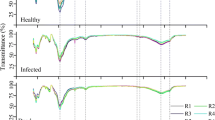Abstract
Significant variations were detected in species composition between untreated rhizosphere and nonrhizosphere soils of tomato plants. Application of different concentrations of active ingredient of the herbicide diphenamid (5–250 ppm) to these soils caused significant alterations in species assemblages as compared with untreated soils. Also variations in species composition were denoted between treated rhizosphere and non-rhizosphere soils.
Diphenamid concentrations of 10–100 ppm significantly affected microbial counts in soil and rhizosphere of tomato plants. Counts have been stimulated at diphenamid concentrations ranging from 10–50 ppm for fungi and 10–100 ppm for bacteria. At concentrations higher than the upper limits of these ranges, R/S values were not significantly affected.
The results also indicated that Fusarium oxyspomm f.sp. lycopersici populations were unaffected by diphenamid at the recommended field rate (10 ppm). Above this concentration and within the conditions of the experiment, the pathogen maintained its population at detectable inocula. Population counts of Aspergillus candidus, a species reported to be able to degrade diphenamid, were high in both treated rhizosphere and non-rhizosphere soils.
Similar content being viewed by others
References
Abdel-Kader MIA, Moubasher AH, Abdel-Hafez SI. Selective effects of five pesticides on soil and cotton rhizosphere and rhizoplane fungus flora. Mycopathologia 1978; 66: 117–23.
Chandra S, Madhu R. Studies on the rhizosphere microflora of tomato. Qualitative and quantitative incidence of microorganisms. Environ India 1983; 5: 15–23.
Curl EA. The rhizosphere relation to pathogen behaviour and root disease. Plant Disease 1982; 66: 624–30.
Dutta BK. Studies on some fungi isolated from the rhizosphere of tomato plants and the consequent prospect for the control of Verticillium wilt. Plant Soil 1981; 63: 209–16.
El-Abyad MS, Ismail IK, Rizk MA. Ecological studies on the rhizospheres of some Egyptian halophytic plants. Egypt J Bot 1982; 25: 91–107.
El-Abyad MS, Ismail IK, Al-Meshhadani SA. Effects of some biocides on Fusarium oxysporum formae speciales causing cotton and tomato wilts in Egypt. Trans Brit Mycol Soc 1983; 80: 283–7.
El-Abyad MS, Abu-Taleb Amira M. Effects of the herbicides simazine and bromophenoxim on the microfiora of two soil-types in Egypt. Zentralbl Bakt 1985; 140: 609–19.
El-Abyad MS, Hindorf H, Rizk MA. Impact of salinity stress on soil-borne fungi of sugarbeet. I. Pathogenicity implications. Plant Soil 1988a; 110: 27–32.
Gentile IA, Bovio M. Fusarium wilt severity and ethylene evolution in tomato plants after treatment with trifluralin and naphthylacetic acid. Z Pflanzenkrank Pflanzenschutz 1986; 93: 624–31.
Gorgina EI, Lyubestkaya OS. Rhizosphere microfiora of cotton destroyed by black root rot. Izv Akad Nauk Turkm SSR Ser Biol Nauk 1980; 6: 44–9.
Johnson LF, Curl EA, Bond JH, Fribourg HA. Methods for studying soil microflora-plant diseases relationships. Burgess, Minneapolis, USA 1959.
Kannaiyan S, Prasad NN. Changes in the rhizosphere microflora of rice on infection with Rhizoctonia solani. Oryza 1981; 18: 246–7.
Katznelson H. The rhizosphere effect of mangels on certain groups of soil micro-organisms. Soil Sci 1946; 62: 343–54.
Kesner CD, Ries SK. The interaction of diphenamid and two soil fungi on the growth of tomato. Weed Sci 1968; 16: 55–7.
Koziova EI, Dikareva TA. Effect of herbicides on microflora of rhizosphere of some agricultural plants. Soil Fert 1963; 26: 253.
Mahmoud SAZ, Zaki MM, Hamed AS, Sahab AF. Rhizosphere microflora of Vicia faba var. equina as influenced by Rhizoctonia solani inoculation and pesticides treatments. Egypt J Microbiol 1980; 15: 53–62.
Mahmoud SAZ, Zaki MM, Hamed AS, Sahab AF. Influence of the organophosphorus insecticides Nuvacron and Diptrex on rhizospheric microflora of broad bean infested with wilt fungi (Fusarium oxysporum f. fabae) and root rot fungi (Rhizoctonia solani). Zentralbl Bakt 1981; 136: 232–8.
Mohammed G. Influence of alachlor and fluchoralin on the rhizosphere and rhizoplane fungi of soybean crop. J Mocharashtra Agric Univ 1984; 9: 303–5.
Stanek M. The interaction of plants and micro-organisms of spermatosphere and rhizosphere after treatment of wheat seeds with thiram. SB Urtiz (Ustav Vedecktotech Inf Zemed) Ochr Rostl 1981; 17: 97–104.
Vishniac H. On the ecology of lower marine fungi. Biol Bull Mar Biol Lab Woods Hole 1956; 111: 410–4.
Warcup JH. The soil plate method for isolation of fungi from soil. Nature (Lond) 1950; 166: 117.
Author information
Authors and Affiliations
Rights and permissions
About this article
Cite this article
El-Abyad, M.S., Ghareeb, M. Changes of tomato rhizosphere microflora following application of the herbicide diphenamid to soil infested with Fusarium oxyspomm f.sp. lycopersici . Mycopathologia 113, 89–94 (1991). https://doi.org/10.1007/BF00442416
Received:
Accepted:
Issue Date:
DOI: https://doi.org/10.1007/BF00442416




